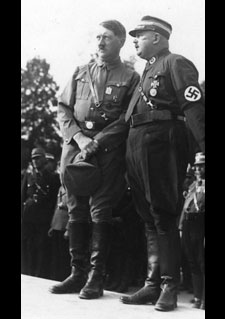The “Night of the Long Knives”
Measures that radically suppressed potential criticism of the regime were taken on various levels in 1934. For instance, the infamous “People’s Court for Cases of High Treason and Treason” was established in April of 1934. A propaganda campaign “against Defeatists and criticasters” was launched in the ensuing months.
There was no longer any desire to suffer criticism even from within the ranks or to allow internal power struggles to arise in the first place. The most spectacular incident was the purge and murder of the SA leadership associated with Ernst Röhm in the summer of 1934. Röhm had pressed for a second revolution with a radical reorganization of society and had pursued the goal of turning the Reichswehr into a new people’s militia.
Hitler settled the smoldering conflict between SA and Reichswehr in favor of the latter. In advance of the murderous action, the SS brought rumors about an imminent putsch by the SA as well as Röhm’s – long known – homosexuality into circulation. Critics of the regime from the conservative and Catholic camp, including Erich Klausener, president of Catholic Action, also fell victim to the purge, which was legalized retroactively by law as “self-defense by the state” to “to suppress attacks of high treason and treason”.
The disempowerment of the SA simultaneously amounted to a rise of the SS and its commander Heinrich Himmler who had already been appointed inspector of the Gestapo in April and placed in control of all of the concentration camps.

